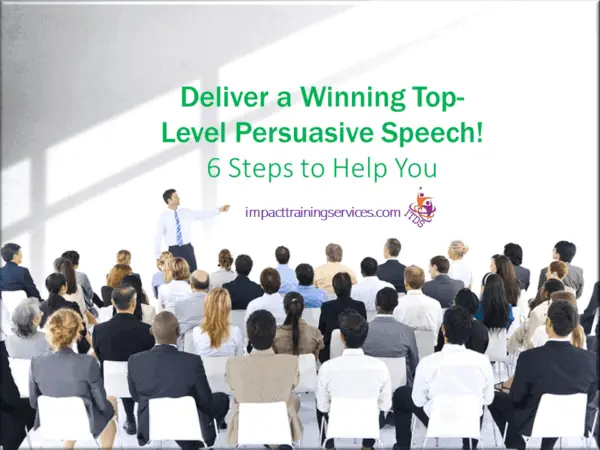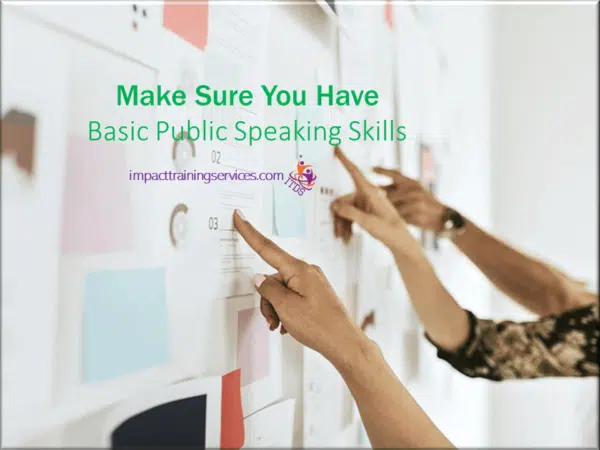Last Updated on March 29, 2024 by Lorna Barrow

“Yes Lorna! I really want to learn how to deliver a Top-Level Persuasive Speech!”
Standing before me, making this declaration, with so much conviction, was a shy-looking young man. Looking at him, I was even finding it hard to believe he was the Financial Controller for a prestigious law firm.
But why was he so passionate in his request?
You see, he had gone to a presentation that was supposed to be dry and even boring. But the presenter had captured and held his interest from beginning to end, talking about pensions. As a result, he believed that the presenter had some “secret” or “insider” speaking skills that he wanted me to teach him.
And he is right…
But apart from acquiring some “insider” or “secret” speaking skills, wouldn’t you just love it if you could combine your voice, your body and your message and deliver your best top-level persuasive speech? Just like I coached him to?
And what if you could leverage your top-level persuasive speeches to influence your team to go the extra mile? Or to convince prospects to consistently choose you over the competition?
Of course you can! And if you want to do so quickly and with expert guidance, click here now!
What is a persuasive speech?
Before I go any further though, let’s be clear what’s a persuasive speech.
It’s that type of speech that you use to motivate your audience to take a specific action. It’s your trusted weapon in your role of “influencer” as you seek to influence people to move from resistance to compliance to commitment. As a business leader, it’s the “transformational speech” you will rely on to transform your workplace.
Benefits of becoming a Top-level Persuasive Speaker
I’m sure you’ve heard me say that if you’re in business, any business, you need public speaking skills. But what no one tells you is that the really big money comes when you become a persuasive speaker.
Here’s the thinking of one of my favorite bloggers, Darius Foroux, that support this.
According to Darius, included in the money-making skills are, persuading, public speaking, communicating and leading. I agree with him, not only in passing but from personal experience, especially as public speaking goes.
It follows then, that when you can easily persuade (don’t confuse this with deceive!) people to understand, accept and buy into your ideas, concepts and positions, you have the opportunity to wield significant power.
In addition, when you deliberately support your persuasion skill with advanced public speaking skills, the rewards are incredible.
So Yes! You too can learn how to deliver a winning persuasive speech. And I will show you how, just liked I showed you how to deliver a winning vote of thanks and how to introduce a speaker.
So if you’re ready, here are the 6 most important steps you must take, if you’re anxious to become a Top-level Persuasive Speaker.
1. Make sure you have basic speaking skills

It’s very difficult, and not very smart, to be trying to present top-level persuasive speeches, when you have not covered the basics of public speaking.
By way of example, here are some of the more important basic speaking skills you should have, to support your upper level speaking skills:
1. how to organise your speech in a meaningful way
2. body language basics – posture, gestures, etc
3. how to make sensible eye contact
4. several ways to open and close your speech
5. the necessity for and the use of vocal variety
6. how to manage your fear of public speaking
7. how to analyse your audience and use the information write a meaningful speech
In addition, there’s another secret reason why it’s necessary for you to have basic public speaking skills.
I have to confess that I’m a big fan of judiciously breaking rules. However, I also believe that you have to know the right way to break the rules, so that you still end up being a winner.
What does that have to do with delivering top-level persuasive speeches?
At this level, it’s about finding and exploiting your competitive advantage. When you know, and can therefore “break” the basic public speaking rules, you establish yourself as a confident speaker, in touch with your true personality.
2. Own your audience for every persuasive speech

I know I told you that audience analysis is a basic speaking skill. And it is…
But when you’re speaking to motivate or transform your audience, analysis is not enough. You have to completely OWN that audience.
To own your audience, you have to be able to identify and influence those elements within your audience, that matter to your goals.
To do this, you have to ask 3 key questions:
First key question – WHO am I speaking to?
To truly answer this question, you have to answer a series of what I call “sub-questions.” For example:
1. What are their roles – Managers? Executive Directors? Decision-makers?
2. What are their needs – to make money? to acquire training that works? Or to keep a partner happy?
3. What are their biases – skeptical/open to the topic? Risk takers or risk averse?
4. How many people have pitched to them before you?
5. How do they feel about you/your business/products/services?
6. What do they know that you can build on?
7. What do they know that you have to overcome?
8. Which stories do they want to hear?
9. What are their concerns – Costs? Viability of product/service?/Kickbacks?
Second Key question – WHAT do I want them to do (after call to action)?
1. Approve the proposal?
2. Give feedback on the proposal by…?
3. Agree to try the product/service?
Third key question – WHY should they do what I want them to?
1. To improve the performance of employees…
2. Avoid the risk of…
3. Reduce the cost of…
4. Look good to the boss…
5. Get their kickback…
Now that you own your audience, you are ready for the next step:
3. Craft a compelling Call to Action (CTA)

One of the benefits of owning your audience is that it allows you to craft a compelling call to action.
Having a captivating CTA is so important. It is the secret ingredient that raises your speech to a higher level and guarantees you the outcome you want.
However, generally, many speeches do not have a message statement and specifically, many persuasive speeches do not have CTAs. Can you believe that?
Well, you’re not going the be caught in that trap.
Once you understand “WHO” you’re talking to, you now need to combine your “WHAT” and your “WHY” into a CTA that your audience just simply can’t ignore.
So let’s set up a scenario so I can show you how it works…
You are speaking to the HR Manager, the Finance Director and the Senior Supervisor of a prestigious local business. (WHO)
And you want them to hire ITDS to provide training for all of their 250 supervisors and middle managers (WHAT).
They have tried other “big name” Training Providers but they have not been happy with the results. They are still having most of the problems this training was supposed to correct. (WHY)
NB: Please just have a single CTA. When you have more than one CTA, it creates confusion in the mind of your audience and this can lead to indecision and eventually no decision.
You now have to craft a compelling CTA that meets the following criteria:
1. Addresses the issues in the “what” and “why”
2. Is specific, clear and short
3. Speaks to any concerns your audience has
4. Does not end in or with a question
5. Is written in the exact words you intend to use in your speech
6. Comes at the end of your presentation
Using the above criteria, your CTA could look something like this:
“So, in closing, we invite you to hire ITDS to train your 250 Supervisors. While it appears at first glance, we have not handled a project of this size before, in reality, larger local and regional firms outsource similar projects to us on a regular basis.
Like many companies, your supervisors have mostly been promoted from within. We have identified the unique problems associated with this approach and have designed a training programme, that not only addresses them but speeds up the transfer of training as well.”
That’s it! Your call to action that ticks all the boxes in just 40 seconds.
You may have to draft several versions until you’re comfortable but it will be worth it.
4. Apply the 3 indispensable pillars of persuasion
Do you ever wonder how people (or you!) get caught by offers in junk mail or informercials?
The answer is simple, really. It’s the power of persuasion at work – that ability to convince you, in short order, that a product or service is the answer to your problem.
Similarly, that’s what you’re going to apply to your speech, to upsize your persuasive appeal and take you even closer to getting what you want.
To do this you need to use some combination of the “3 pillars of persuasion”.
Let’s look at them in more detail now.
1. Logic
This is where you will place the facts, figures, statistics and other forms of documentation which support your point. Make sure these are from credible sources and that you share these sources.
Please note, you should provide evidence which supports your position. General information on the topic will not be enough, so be careful with your research.
You see, your “logic” ultimately represents a combination of truthful, accurate and relevant information, supported by logical argument.
2. Emotion
Many of you mistakenly rely on logic alone to be persuasive but this is not enough, however sound your logic is.
Any good salesperson will tell you that people buy with emotion and justify the purchase with fact. It’s the same with making a presentation…grab them by the emotion and convince them with the facts.
To be able to do this, you have to know you audience so well that you “own them”. Remember?
3. Credibility
As a Top Level Speaker, when delivering a persuasive speech, you want your audience to perceive you as at least competent, honest and trustworthy. These are also the basic components of credibility.
Of the 3 pillars, credibility is the one that you really want to master to get the results you want.
So how do you nail it?
First establish your competence. You can do this easily by stating your credentials and achievements in your introduction. Be truthful without exaggeration. In other words, be honest.
Your honesty is located in your logical approach. Remember I said it is a combination of “truthful, accurate and relevant information”.
Now how do you establish your trustworthiness? Here are 3 approaches I find works well.
1. Find common ground with your audience. For example:
“I am as concerned about clients getting value for their training dollars as I know you are!”
2. Share info or tell a story about a time when you were not so “hot”. That works something like this:
“We were not always this good at writing proposals. As a matter of fact, we’re quite embarrassed when we look back at our early proposals!”
3. Get your CTA right.
Take another look at the CTA in step #3 above. You will notice that in addition answering the “why” and the “what” questions about your audience, it supports the 3 indispensable pillars of persuasion.
5. Select the best “persuasive speech” approach

When you are delivering a top-level persuasive speech, you’re actually performing the ceremonial leadership role of influencer.
To me, influence is:
How you move people from resistance to compliance to commitment…
To be able to do this, you need to know what position your audience is likely to take with regards to your point of view or what you’re proposing.
Here are 3 positions your audience are likely to take and some suggestions on how to deal with them:
1. If the audience opposes your views:
1. Strive to have the audience recognize the merits of your position and reconsider their own view
2. Be respectful and sensitive about the beliefs of others
3. Establish common ground, focusing on the facts on which you both agree
4. Don’t backdown from your position
5. Present your message fairly, not trampling on the feelings of your audience
6. Make a CTA
2. If the audience is neutral or unconcerned:
1. Convince the audience the issue affects them and is important to them
2. If it’s a problem, show your audience how it relates to them and their lives
3. Explain each possible solution and show how yours is the best alternative
4. Present your side first, dispose any counter-arguments, restate yours
3. Make a CTA
3. If the audience agrees with your point of view:
1. Reinforce and strengthen this agreement
2. Acknowledge opposing views and present evidence to support yours
4. Give your audience solid reasons for agreement
5. Bring passive belief up to active commitment
6. Make a CTA
6. Package your persuasive speech professionally
Question: What do you want a package to do for your product?
Answer: I want a package for my product to be fit for purpose, to promote my brand and bring me customers!
Well…just as packaging matters to your product, equally, “packaging” matters to your speech.
So here are some tips to help you “package” your speech so it’s the final stamp of goodwill for your audience and further proof of your credibility.
1. Deliver the presentation in a professional, convincing manner
If you really want to motivate people to take action, here’s what must happen. You have to plan, write, and deliver your presentation in a professional, convincing manner. You don’t want to be remembered for the wrong reason.
That’s why you need to know the fundamental of public speaking to deliver at the top level. Can you imagine anyone being convinced by a sloppy speaker delivering an incoherent speech?
2. Analyse and own your audience
Again, analysing and “owning” your audience is extremely important. I know it feels like I have told you this 37 times before. But guess what? I will repeat it until people stop speaking in public.
The more you know about the audience, the better you can prepare everything- content, slides, environment, stories, etc. I don’t have to tell you that the better prepared you are, the easier it is to present your CTA!
3. Decide how you will arrange your information
As part of your preparation, decide how you will arrange your information. You need to know what charts, slides, etc , you will use to enhance your words and to create the right atmosphere for the audience to take in that information.
One of the best ways to help your audience understand and retain the information that you’re sharing, is to organize it in a simple format that they can follow step by step. For example:
-
- Past – Present – Future
- Before – During – After
- Problem – Cause – Solution
5. Use stories to appeal to the audience’s emotions
Telling a story, especially about a personal experience, is the best way I know to connect with you audience.
Stories help your audience to visualize circumstances, and understand complex information. At the same time, they allow you to make an emotional connection with your audience and present you as human.
In telling stories though, just remember…
-
- Your stories should fit in with the context of your presentation
- Make your stories relevant to the experience and interests of your audience
- Use stories sparingly
- Practice them along with the rest of your speech
6. Dress professionally
Don’t forget…Just as important as what you say, is how you look. You cannot do anything about the shape of your nose and the colour of your eyes (well maybe!) but you can do so much about your clothes and attitude.
So plan to dress professionally. Start by understanding what dressing professionally means and don’t be hesitant about seeking help from an image consultant. Don’t let how you look, undermine what you say.
7. Handle the Q and A professionally
This is so important that I want to refer you to this bog post which covers the topic in compelling detail.
Your next “persuasive speech” step
Becoming a persuasive speaker is one of the most important communication skills you can acquire for yourself and your business.
I’ve shared 6 key steps which you can follow, with links to even more help, so you can really nail it.
Your next step is to take these tips and write a speech that ticks each box. Then practice it on your team or a group of friend or at your Toastmaster Club.
When you do, you would have placed yourself in a position to be above the competition the next time out.
If you think your persuasive speaking skills are already “all that and a pack of nuts” then use these tips as a checklist to make sure you’re at least covering the basics.
Whichever it is, you need to act now! You and your business need you to be a Top-Level Persuasive Speaker!



